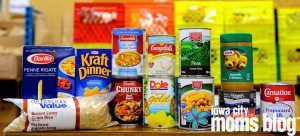During the school year, 22 million children receive free or reduced-priced meals through the National School Lunch Program. When school is out for summer, only 2.7 million children receive free or reduced-price meals. This gap of 1 in 8 summer to school-time participants is the result of various barriers experienced only during the summer, including a lack of access to meal sites, insufficient program awareness, and limited resources when schools are closed.
The gap is even worse in Eastern Iowa, where 1 in 4 children are going hungry.
Most food drives take place around the Holiday Season, but here in Eastern Iowa, food drives often take place in the summer to help alleviate the 1 in 4 children who do not have access to a school lunch. Sometimes, however, summer food drives face challenges in the form of the type of products that are donated.
Many people use summer as a time to clean out their basements, garages, and in the case of food drives, their pantries. I have to admit, that before I was the Director of the HACAP Food Reservoir (an Eastern Iowa Food Bank that provides food to over 100 partner agencies across the state), I was guilty of using food drives to get rid of food that was old and taking up space in my cupboards. An old cake mix never used…I donated it. Some gravy packets never used…I donated it.
But now I know better, and as a mother, I try to think about the mother that is receiving my donations. If all your meals came from a donation box, what would you want to find there?
- Think simple. “Just add water” is more helpful then a mix that requires more ingredients like butter, eggs and oil. Many households lack proper refrigeration.
- Do give no-cook food. Items such as granola bars, crackers, Spam, tuna and peanut butter. Many households lack access to a stove.
- Don’t give outlandish items. If you didn’t want that can of olives or jar of capers, chances are other households won’t use them either.
- Make it easy to open. This is especially important for our homeless clients and our senior clients. It is also important for our children, who are often left home alone and are required to feed themselves.. Sterile packages are better than pull-top cans, which are better than traditional cans. Imagine how tough it would be to stare at a perfectly good can of food that you can’t open.
- Leave food in the original packaging. There are many food safety rules and re-packaging is usually not a viable option
- Consider donating cash. For instance, The HACAP Food Reservoir can buy 7 pounds of food for $1 donated. This is due to our access to lower prices and our relationships with food vendors. Most Food Banks are similiar.
- Donate your excess produce. Fresh fruits and vegetables are so appreciated. When your garden goes nuts you can rest assured our clients will snap up your surplus apples or zucchini.
As a Registered Dietitian, I also am aware that the health of the food insecure is suffering. There is a delicate balance between healthy food by a dietitian’s standards and the healthiest options for food insecure families. Hunger and obesity live in close quarters. Their existence sounds contradictory, but those with insufficient resources to purchase adequate food can still be overweight, for reasons that researchers now are beginning to understand. Much of the junk food comes from grocery stores, which donate old or damaged products. But food bank leaders are reluctant to get picky with their biggest donors because we get good stuff from retailers, too, like milk and vegetables. We give it out because if we don’t take it, we won’t get other food from people when they’re distributing it. We try to find the best balance possible. We also realize, that just like our own children, a treat is nice to have once in awhile, and so a box of cookies is welcomed.
Most Food bank leaders still acknowledge the responsibility to watch what their clients are eating. Feeding America, a national umbrella group, has set a five-year goal to get 75 percent of what’s distributed classified as nutritious. Below is a list of nutritious, yet non-perishable items that you can donate:
-
100% Juice Drinks
Food banks like to have juices on hand, especially for kids, but juices with high fructose corn syrup can be harmful for kids who are struggling to get proper nutrition.
-
Low-Sodium Vegetables
Mixed vegetables are also a good option because they make for more colorful and well-balanced meals.
-
Canned Tuna and Chicken
These items are non-perishable and can be added to many meals for a much-needed protein boost.
-
No-Sugar-Added Fruits
Canned fruits and fruit cups are good snacks for kids, high in Vitamin C and nutrients, and keep well on food bank shelves. Packed in natural juices and water is best.
-
Shelf-Stable Milk
Milk is a great source of calcium and protein, but it’s hard for food banks to buy and keep fresh milk. Food banks are always in need of shelf-stable and/or powdered milk that will last longer and travel well.
-
Whole Grain Pasta
Pasta is a filling non-perishable good that goes a long way, but white pasta doesn’t have a high nutritional value.
-
Canned Beef Stew
Canned beef stew is an all-purpose, non-perishable food. It’s a warming meal full of meats, veggies, and complex carbohydrates.
-
Canola and Olive oils
These items are highly sought after by most food banks. Oil is important for cooking, and these oils provide relatively healthy calories thanks to their mono-unsaturated fats.
-
Peanut Butter
Peanut butter is another protein-rich food that’s always in high demand.
-
Low-Sodium Soups
Like stews, soups are a great way to get all of the food groups together in one bowl. Again, most food banks prefer lower-sodium soups to make sure people seeking assistance are getting healthy meals as often as possible.
And finally, food banks are always looking for healthy snacks to give out, especially to families with kids. Granola bars are a good choice because they keep well and they’re fairly healthy, as long as you choose brands that aren’t packed with sugar.
I hope this information is helpful. The Iowa City Mom’s Blog Team will be hosting a Food Drive in early August. Be on the lookout for more information as to how you can get involved. Together, mothers can help solve hunger! To read my first post in this series, click here.













